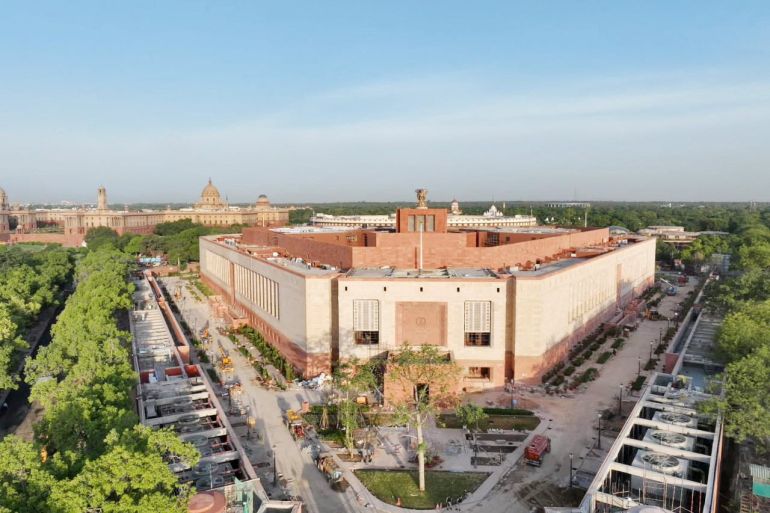Why a map in India’s new parliament has riled its neighbours
Bangladesh, Nepal and Pakistan express displeasure over ‘Undivided India’ mural in the recently inaugurated building.

The installation of a map in India’s newly inaugurated parliament building has riled its South Asian neighbours, including Bangladesh, Nepal and Pakistan.
Bangladesh’s foreign ministry on Monday sought an explanation from New Delhi over the Akhand Bharat, or Undivided India, map in the new parliament building, inaugurated by Prime Minister Narendra Modi late last month.
Keep reading
list of 4 itemsNepal Parliament approves new map that includes land India claims
India’s updated political map stirs controversy in Nepal
Hindu group files case against Twitter over ‘distorted’ India map
The map includes parts of Afghanistan, and the entire Pakistan, Nepal, Bangladesh, Sri Lanka and Myanmar.
The Bangladeshi embassy in the Indian capital has been instructed to contact India’s foreign ministry to get India’s official explanation on the matter, Bangladesh’s junior minister for foreign affairs, Shahriar Alam, told reporters in Dhaka.
“Anger is being expressed from various quarters over the map. There is no reason to doubt … the installation of the map. However, we have asked our mission in New Delhi to speak to the Indian ministry of external affairs to find out what their official interpretation is,” Alam said.
India’s foreign ministry spokesperson Arindam Bagchi said in a media briefing the mural depicts the spread of the ancient Mauryan Empire and “the idea of responsible and people-oriented governance that [King Ashoka] adopted and propagated”.
However, during the inauguration of the new parliament building on May 28, India’s minister for parliamentary affairs as well as coal and mines, Pralhad Joshi, had described the mural as a map of the Akhand Bharat – a decades-old, right-wing fantasy that imagines an ethnic Hindu nation in the subcontinent.
“The resolve is clear – Akhand Bharat,” says a translation of Joshi’s tweet.
ಸಂಕಲ್ಪ ಸ್ಪಷ್ಟವಾಗಿದೆ – ಅಖಂಡ ಭಾರತ 🇮🇳#NewParliamentBuilding#MyParliamentMyPride pic.twitter.com/tkVtu3CCoh
— Pralhad Joshi (@JoshiPralhad) May 28, 2023
Joshi’s reference to some idea of an “undivided” India did not go down well with its neighbours.
“If a country like India that sees itself as an ancient and strong country and as a model of democracy puts Nepali territories in its map and hangs the map in parliament, it cannot be called fair,” Nepal’s former Prime Minister KP Sharma Oli was quoted as saying in The Kathmandu Post newspaper.
Oli asked the Nepalese Prime Minister Pushpa Kamal Dahal, who visited India last week, to “ask [the Indian government] to remove the mural” and “correct that mistake.”
“There is no point in visiting India if you can’t do that,” Oli told the Nepalese newspaper.
According to Indian media reports, Dahal did not raise the map in his meetings with his Indian counterpart, Narendra Modi, or other officials.
The mural depicts Nepal’s ancient sites such as Lumbini – the birthplace of Lord Buddha – and Kapilvastu as part of the “Greater India” map.
Last week, Pakistan also expressed ” grave” concerns over the idea of Akhand Bharat being increasingly peddled by India’s ruling dispensation.
At a weekly news briefing in Islamabad, Pakistani foreign ministry spokesperson Mumtaz Zahra Baloch said the assertion in the map was “a manifestation of an expansionist mindset that seeks to subjugate the ideology and culture not only of India’s neighbours but also its religious minorities”.
So far, there has not been any official statement from Sri Lanka, Afghanistan or Myanmar on the matter.